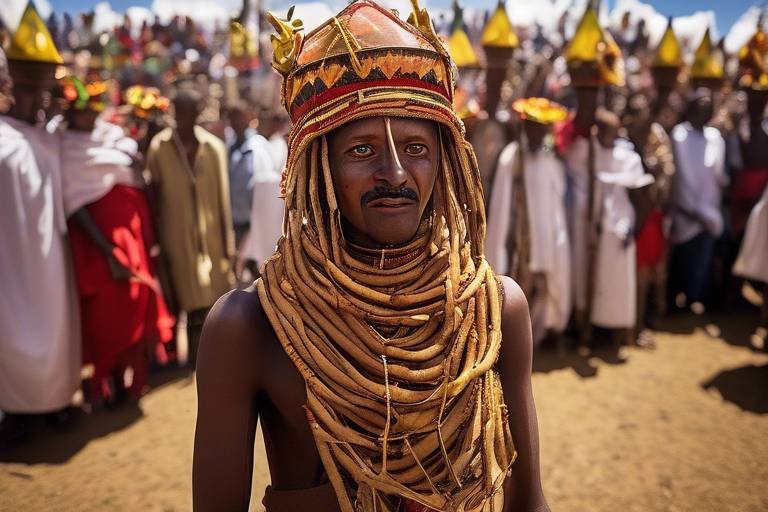Exploring Brazil’s Festival of the Círio de Nazaré
The Círio de Nazaré festival in Brazil is a vibrant and significant religious celebration that honors the Virgin of Nazareth, attracting millions of pilgrims and tourists each year. Originating in the 18th century, this grand event has evolved into a cultural extravaganza that showcases the deep devotion and spiritual practices associated with Brazilian Catholicism.
As one of the most anticipated festivals in Brazil, the Círio de Nazaré holds immense religious significance within the hearts of the Brazilian people. The festival serves as a testament to the unwavering faith and profound reverence for the Virgin of Nazareth, embodying a rich tapestry of traditions and customs that have been passed down through generations.
Immersing oneself in the Círio de Nazaré festival means delving into a world of traditional practices and customs that are deeply rooted in Brazilian culture. From symbolic rituals and processions to heartfelt prayers and offerings, participants engage in a spiritual journey that transcends the boundaries of time and space.
Iconic symbols and images permeate the atmosphere of the Círio de Nazaré festival, capturing the essence of devotion and celebration. The statue of the Virgin of Nazareth stands as a beacon of faith, while candlelit processions and vibrant decorations adorn the streets of Belém, creating a visual spectacle that mesmerizes all who witness it.
The impact of the Círio de Nazaré festival extends far beyond its religious roots, shaping the cultural identity of the people of Belém and leaving an indelible mark on Brazilian society as a whole. This annual celebration fosters community bonds, preserves traditions, and boosts tourism, showcasing the rich tapestry of Brazilian heritage.
During the festival, a diverse array of celebratory events and activities unfold, offering a kaleidoscope of experiences for participants and spectators alike. From solemn religious ceremonies and mass gatherings to lively music performances, art exhibitions, and delectable culinary delights, the Círio de Nazaré festival is a feast for the senses.
With its growing global recognition, the Círio de Nazaré festival has become a magnet for pilgrims and visitors from around the world, drawn to its unique blend of faith, tradition, and cultural vibrancy. This global participation underscores the festival’s universal appeal and its ability to transcend geographical boundaries.
Looking ahead, the Círio de Nazaré festival faces the challenge of balancing tradition with modernization, ensuring its sustainability in a rapidly changing world. Preserving its heritage, promoting inclusivity, and adapting to evolving societal dynamics are key factors in securing the festival’s future and continued relevance.
History of the Círio de Nazaré
The history of the Círio de Nazaré festival is a fascinating journey that dates back to the 18th century, rooted in a tale of miraculous events and unwavering faith. It all began with a humble wooden statue of the Virgin of Nazareth, brought to Belém by a Portuguese soldier in 1700. Legend has it that despite numerous attempts to move the statue, it always found its way back to the soldier’s home, leading to the construction of a chapel in honor of the Virgin. This marked the inception of what would later become the grand festival of Círio de Nazaré, symbolizing the enduring bond between the people of Belém and their revered patroness.
Over the years, the festival evolved from a local religious observance to a massive annual event that draws millions of pilgrims and tourists from far and wide. The Círio de Nazaré has grown in scale and significance, becoming a symbol of faith, unity, and cultural heritage for the people of Brazil. It stands as a testament to the enduring power of tradition and the deep-rooted spirituality that permeates every aspect of Brazilian society.
The transformation of the Círio de Nazaré festival mirrors the rich tapestry of Brazilian history, blending indigenous, European, and African influences into a vibrant celebration of faith and devotion. It serves as a testament to the resilience and creativity of the Brazilian people, who have preserved and cherished their religious traditions amidst changing times and societal dynamics.
Religious Significance
The of the Círio de Nazaré festival is deeply rooted in Brazilian Catholicism, symbolizing the strong devotion to the Virgin of Nazareth. This annual celebration holds immense spiritual importance for believers, drawing pilgrims and worshippers from far and wide to participate in the sacred rituals and pay homage to the revered figure of the Virgin Mary. The festival serves as a time of reflection, prayer, and unity, where individuals come together in faith to seek blessings, offer thanks, and strengthen their spiritual connection.
Traditional Practices and Customs
When delving into the rich tapestry of the Círio de Nazaré festival, one cannot overlook the profound significance of its traditional practices and customs. These age-old rituals serve as the heartbeat of the celebration, infusing it with a sense of sacredness and cultural heritage that resonates deeply with participants and spectators alike.
At the core of the festival’s customs lies the mesmerizing procession that winds its way through the streets of Belém, with throngs of devotees carrying the ornately adorned statue of the Virgin of Nazareth. This solemn yet jubilant march symbolizes faith, unity, and reverence, drawing pilgrims from far and wide to partake in this spiritual journey.
Participants clad in traditional attire, their faces illuminated by the flickering glow of candles, offer prayers and supplications to the Virgin, seeking her blessings and protection. The air is filled with the melodious strains of hymns and chants, creating a mystical ambiance that transports onlookers to a realm where the divine meets the earthly.
Throughout the festival, offerings of flowers, fruits, and symbolic gifts are laid at the feet of the Virgin, signifying gratitude, devotion, and the eternal bond between the faithful and their celestial patron. These gestures of piety serve as a testament to the enduring traditions that have been passed down through generations, forging a connection between the past, present, and future.
Moreover, the culinary delights that abound during the Círio de Nazaré festival are a testament to the vibrant tapestry of Brazilian gastronomy, with traditional dishes and delicacies served up in abundance to nourish the body and soul. From mouth-watering seafood feasts to delectable sweets and treats, the festival is a feast for the senses, inviting all to partake in the joyous bounty of the land.
As the sun sets over Belém and the flickering candlelights cast a warm glow over the gathered throngs, one cannot help but be swept away by the magic and majesty of the Círio de Nazaré festival. It is a time-honored tradition that weaves together faith, culture, and community, uniting hearts and minds in a celebration of love, devotion, and the enduring spirit of Brazil.
Iconic Symbols and Images
When it comes to the Círio de Nazaré festival, there are several iconic symbols and images that hold deep cultural and religious significance. One of the most prominent symbols is the statue of the Virgin of Nazareth, a revered figure that serves as the focal point of the celebration. This statue, adorned with intricate details and rich colors, is paraded through the streets of Belém during the festival, drawing crowds of devoted pilgrims and spectators alike.
Another iconic aspect of the Círio de Nazaré festival is the candlelit processions that illuminate the night sky with a warm and spiritual glow. These processions, where participants carry candles and lanterns as they walk in honor of the Virgin of Nazareth, create a mesmerizing sight that symbolizes hope, faith, and unity among the community.
Furthermore, the vibrant decorations that adorn the streets of Belém during the festival are a visual feast for the eyes. Colorful banners, intricate floral arrangements, and ornate displays pay homage to the Virgin of Nazareth and create an atmosphere of joy and festivity that permeates throughout the city.
One cannot overlook the traditional attire worn by participants during the Círio de Nazaré festival, which adds to the spectacle and cultural richness of the event. From elaborate costumes to symbolic accessories, the clothing worn by pilgrims and performers reflects the deep-rooted traditions and customs associated with the celebration.
Overall, these iconic symbols and images play a crucial role in capturing the essence and spirit of the Círio de Nazaré festival, serving as visual representations of faith, devotion, and community unity that define this vibrant cultural event.
Impact on Local Culture
The impact of the Círio de Nazaré festival on the local culture of Belém is profound and multifaceted. This vibrant celebration plays a pivotal role in shaping the cultural identity of the city and its people, fostering a sense of community and belonging among residents. The festival’s traditions and customs have become deeply ingrained in the local fabric, influencing various aspects of daily life and social interactions.
One of the most significant impacts of the Círio de Nazaré festival is the way it brings people together, transcending social barriers and uniting individuals from diverse backgrounds in a shared experience of faith and celebration. The sense of camaraderie and solidarity that permeates the festival creates a strong sense of belonging and pride among the residents of Belém, reinforcing their cultural heritage and sense of identity.
Moreover, the festival serves as a platform for the preservation and promotion of traditional practices and customs that are integral to the local culture. Through colorful processions, lively music, and elaborate decorations, the Círio de Nazaré festival showcases the rich cultural heritage of Belém, attracting visitors from far and wide who come to witness and participate in the festivities.
Furthermore, the economic impact of the Círio de Nazaré festival on the local community is significant, as it generates revenue for businesses, artisans, and vendors who participate in the event. The influx of tourists and pilgrims during the festival season boosts the local economy, supporting small businesses and contributing to the overall prosperity of the region.
Overall, the Círio de Nazaré festival is not just a religious event but a cultural extravaganza that shapes the social fabric of Belém and leaves a lasting impact on the local community. From promoting unity and solidarity to preserving traditions and stimulating economic growth, this vibrant celebration continues to be a cornerstone of the city’s cultural heritage and identity.
Celebratory Events and Activities
The Círio de Nazaré festival in Brazil is not just a religious event but a vibrant celebration that offers a plethora of celebratory events and activities for participants and spectators alike. From the traditional religious ceremonies to the lively cultural performances, this festival is a melting pot of traditions and modern festivities that cater to a diverse audience.
One of the main highlights of the Círio de Nazaré is the grand procession in which the statue of the Virgin of Nazareth is carried through the streets of Belém amidst a sea of devotees. This solemn yet joyous parade is a sight to behold, with thousands of pilgrims joining in the procession, offering prayers and expressing their devotion to the Virgin Mary.
Music plays a significant role in the celebratory atmosphere of the festival, with live performances by local artists and traditional music bands filling the air with melodious tunes. The rhythmic beats of drums and the soul-stirring chants create an ambiance of festivity and reverence, adding a dynamic element to the event.
Art lovers can indulge in the various exhibitions and displays that showcase the rich cultural heritage of Brazil, from intricate handicrafts to vibrant paintings depicting religious themes. These artistic expressions not only add color to the festival but also serve as a platform to promote local talent and creativity.
Food enthusiasts are in for a treat during the Círio de Nazaré, as the streets come alive with food stalls offering a wide array of traditional delicacies and culinary delights. From savory snacks to sweet treats, visitors can savor the flavors of Brazilian cuisine while immersing themselves in the festive spirit.
For those seeking a more immersive experience, interactive workshops and cultural activities are organized to engage participants of all ages. From dance classes to craft demonstrations, these hands-on experiences provide a deeper insight into the traditions and customs associated with the festival, fostering a sense of community and camaraderie among attendees.
Global Recognition and Participation
Global Recognition and Participation in the Círio de Nazaré festival have been steadily increasing over the years, drawing pilgrims and visitors from various corners of the globe to partake in this unique cultural extravaganza. The festival’s reputation has spread far beyond the borders of Brazil, attracting individuals seeking to witness the vibrant displays of faith and tradition that define the event. Pilgrims from different countries arrive in Belém, eager to immerse themselves in the spiritual atmosphere and join the local community in honoring the Virgin of Nazareth.
Future Prospects and Sustainability
As we look ahead to the future of the Círio de Nazaré festival, there are both exciting prospects and important considerations for its sustainability. The festival’s rich history and cultural significance provide a strong foundation for its continued success, but challenges lie ahead in preserving its heritage and ensuring inclusivity in the face of modernization.
One key aspect of securing the future of the Círio de Nazaré is the need to balance tradition with innovation. While honoring the festival’s time-honored rituals and practices is essential for maintaining its authenticity, embracing new ideas and technologies can help attract younger generations and ensure its relevance in a rapidly changing world.
Moreover, sustainability is a crucial factor to consider in the long-term viability of the Círio de Nazaré. As the festival continues to grow in popularity and scale, efforts must be made to minimize its environmental impact and promote responsible practices among participants and organizers. This could involve initiatives such as waste management programs, eco-friendly transportation options, and the use of sustainable materials in decorations and offerings.
Another important aspect of ensuring the festival’s sustainability is fostering community engagement and support. By involving local residents, businesses, and authorities in the planning and organization of the Círio de Nazaré, a sense of ownership and pride can be instilled, leading to greater participation and investment in its success for years to come.
Looking forward, it is essential for the organizers and stakeholders of the Círio de Nazaré to adapt to changing societal dynamics while staying true to the festival’s core values and traditions. By embracing innovation, promoting sustainability, and fostering community partnerships, the Círio de Nazaré can continue to thrive as a cherished cultural event that unites people in faith and celebration.
Frequently Asked Questions
- What is the significance of the Círio de Nazaré festival?
The Círio de Nazaré festival is a significant religious event in Brazil that honors the Virgin of Nazareth. It holds deep cultural and spiritual importance, drawing millions of pilgrims and tourists each year to participate in the celebrations.
- What are some traditional practices associated with the Círio de Nazaré festival?
Traditional practices of the festival include processions, rituals, prayers, and offerings made by participants to show their devotion to the Virgin of Nazareth. These customs have been passed down through generations and are integral to the festival’s rich heritage.
- How has the Círio de Nazaré festival impacted local culture?
The festival has had a profound influence on the cultural identity of the people of Belém and Brazil as a whole. It has shaped traditions, strengthened community bonds, and played a significant role in promoting tourism in the region, showcasing the vibrant cultural heritage of the area.
- What kind of events and activities can one expect during the Círio de Nazaré festival?
During the festival, a diverse range of events and activities take place, including religious ceremonies, mass gatherings, music performances, art exhibitions, and culinary delights. These offerings cater to a wide audience and contribute to the festive atmosphere of the celebration.
- How does the Círio de Nazaré festival contribute to global recognition and participation?
The festival’s growing global recognition has attracted pilgrims and visitors from around the world who seek to witness and partake in this unique cultural experience rooted in faith and tradition. This international participation has helped to elevate the festival’s profile on the global stage.
- What are the future prospects and challenges facing the Círio de Nazaré festival?
As the festival moves forward, there are challenges in preserving its heritage, promoting inclusivity, and ensuring sustainability in the face of modernization and societal changes. Addressing these issues will be crucial in maintaining the festival’s cultural significance for future generations.
Brazil, Festival, Círio de Nazaré, Belem, Pilgrimage, Celebrations, Tradition, Religious., , Brazil, Festival, Círio de Nazaré, Belem, Pilgrimage, Celebrations, Tradition, Religious.,
Share this content:














Post Comment